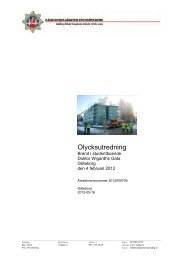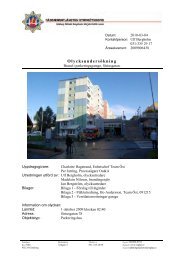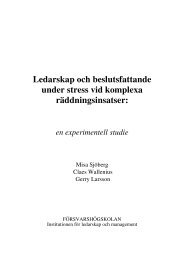Sverige
Sverige
Sverige
You also want an ePaper? Increase the reach of your titles
YUMPU automatically turns print PDFs into web optimized ePapers that Google loves.
kris och lärdom 7<br />
can take place elsewhere and sometimes even far away<br />
from the local area. Almost all of these events have a<br />
beginning and an end, in that an event takes place and<br />
causes a response that is concluded at a specific time.<br />
According to ’t Hart & Boins (2001) typology,<br />
most of the disasters in this study can be defined as<br />
fast burning crises because they began and ended suddenly.<br />
Some, like floods, can be described as slow-burning<br />
crises. There are hardly any examples of disasters<br />
with a slow start and a fast end. The most serious historical<br />
disasters can be described as a fourth category,<br />
long-shadow crises, which erupt suddenly and have<br />
a prolonged aftermath, typically Chernobyl, Estonia,<br />
the Gothenburg disco fire and the environmental damage<br />
caused by the construction of the Halland Ridge<br />
tunnel. Because of the damage that was caused, one<br />
of the two disasters in this study, the January storm,<br />
can be classed as the latter. The tsunami disaster also<br />
belongs to this category at national level, but hardly<br />
at local level because there were no prolonged repercussions<br />
at local level.<br />
The discussion in research circles that crises do<br />
not end but become part of an ongoing process can<br />
be both confirmed and contradicted by the cases in<br />
this study. Several crises have had a definite beginning<br />
and a definite end. At the same time, a number<br />
of localities and regions have been affected by several<br />
recurring disasters which could make the crisis phenomenon<br />
ongoing, even though the events have taken a<br />
different form. During recent years, however, it seems<br />
that some localities and areas have experienced repeated<br />
natural disasters such as storms, floods, snow<br />
storms and even train accidents. At the time of writing<br />
(2007), municipalities in Småland are experiencing a<br />
new storm, similar to the January storm of 2005.<br />
Whether these extreme events have constituted a<br />
crisis in the sense that they caused a critical and serious<br />
situation is another question. Whether something<br />
creates a crisis is based on two main factors– that the<br />
event caused widespread and serious or irreparable<br />
damage in the local community of various kinds, and<br />
that the response operation and communication led<br />
to legitimacy problems for officials and the concerned<br />
authorities.<br />
The events in this study– the tsunami disaster and<br />
the storm – differ somewhat from each other in this<br />
respect. The tsunami was certainly a serious crisis situation<br />
internationally because it took place on another<br />
continent and the victims came from many different<br />
countries. This did not constitute a crisis for Swedish<br />
municipalities in terms of loss or legitimacy, apart<br />
from metropolitan areas where loss took the form of<br />
many dead inhabitants. The tsunami disaster created<br />
a legitimacy crisis at government level, however (SOU<br />
2005). The storm disaster should be categorized as a<br />
local crisis, however, because local communities experienced<br />
major damage of different kinds, but the efforts<br />
to handle the crisis and communicate during the<br />
crisis can hardly be described in crisis terms (except<br />
for one point, the power and telecom companies’ response<br />
and communication in the storm case).<br />
Neither can the “old” extreme events or serious social<br />
disruptions that are included in this study be considered<br />
crises in the sense of a critical outcome. They<br />
are mostly incidents that have not entailed any loss<br />
of legitimacy for the political or public administration<br />
system nor caused irreparable damage in most cases.<br />
Organization<br />
The definitions used by local emergency and disaster<br />
response organizations are often based on whether<br />
assistance is required from national level or from<br />
external organisations with specific disaster management<br />
competence. This conclusion emanates however<br />
from US-based studies where the local authority (equivalent<br />
to a Swedish municipality) usually has fewer<br />
resources and less responsibility than in Sweden. Swe-

















